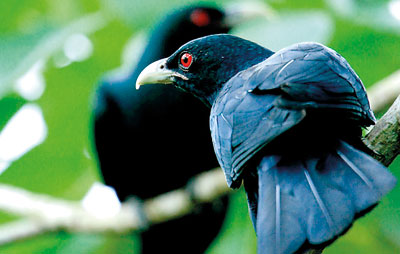News
The elusive New Year messenger
View(s):By Malaka Rodrigo
Today is Avurudu but have you heard the messenger of the New Year, the koha? The song of the koha, or the Asian Koel, is a special part of the Avurudu season, like the Western cuckoo is termed the first harbinger of Spring. But do we hear the koha’s melodious song as frequently as in the past or is it fading away like other Avurudu symbols such as erabadu flowers and cadju puhulam?

Pic by Udara Samara Samaraweera
Some readers reported hearing koha’s song less frequently this year. “I haven’t heard the koha in my neigbourhood,”lamented Gayani Karunatilake, who lives in Nugegoda. Reaction is varied. Responding to a query posted on the Facebook group“Nature”, Kavinda Jayasooriya said he noticed koha calls had increased this year.
Posting on the same group, Jagath Gunawardane, an ardent birdwatcher, said that based on his observations the koha’s call was less frequent now. “The calling reached a peak during the last days of March, and now we are having a reduction in calling. It will be even less during the New Year days,”he predicts.
Sarath Ekanayake, had a different view. “During March-April this year, kohas could not be seen or heard in my surrounding area around Kandy,” he said.
“I saw the koel in February but haven’t heard the calling.” Mr Ekanayake also shared an interesting observation from a villager of Ambalangoda who said the koha was being found in large numbers in home gardens in the area, sometimes in flocks of five to seven birds.
Another interesting observation that the koha is now making that “culturally important” call not only in April, but in a highly random manner throughout the year. The Asian koel is omnivorous, and the large numbers of crows solve their housing needs so the bird can adapt to rapid urbanisation. Ornithologists in general do not see a decline of its numbers. “But no one can say that even the koha is perfectly safe as there can be unexpected phenomena affecting even common birds,” says Chandima Fernando of the Field Ornithology Group of Sri Lanka (FOGSL).
“The house sparrow was once very common around Sri Lanka. But they are not to be seen any more in many areas. This population decline could have occurred over a period of time but because we haven’t monitored them, we didn’t realise they were in trouble,” he said.
Addressing the Annual BirdWatchers’ Conference organised by FOGSL on March 30, Mr. Fernando said everyone could help in the conservation of birds by properly documenting and sharing those casual observations.
“If you observe the birds around you throughout the year, you can easily monitor any changing patterns of different birds” he added. “Different people have different perceptions on whether the Asian koel is found in their gardens as frequently as last year and whether its song is heard.
“If we kept a record last year on days we heard the koha, or the numbers in which they visited our gardens, then we can compare those records and make conclusions as we have a data set to compare.” These simple observations collectively could be used as scientific data to monitor any decline or change in population.
Mr. Fernando also revealed that FOGSL plans to launch another Citizen Science program called “Garden Bird Watch” and welcomes the Sunday Times readers interesting in joining the initiative to send an e-mail to fogslcs@gmail.com or call FOGSL secretariat on 011-2501332.
Perhaps this Aluth Avurudu is the best time to pay some attention to the common birds. Why not start by observing the koha this year? If you can capture any photographs of kohas, send them to the Sunday Times.
The bandit bird
The Avurudu song of the koha is the song of the male vying with other cuckoos to impress a mate. The melody signals the start of the breeding season, which usually coincides with the April festive season. As the koha’s melodious song is seasonal it is commonly believed that the Asian koel is a migratory bird but Prof.Sarath Kotagama says this is a misconception. The Asian koel could be seen in our home gardens throughout the year if we look closely.
The Asian koel, like many other cuckoos, lay eggs in the nests of other species. Different cuckoos target the nests of different birds. Our beloved “Avurudu koha”selects the crows as foster parents for its young. The male koel deliberately distracts the crows to allow the female koel to lay its egg in the crow’s nest. A single egg is usually laid, and sometimes the female egg even throws out the host’s egg.
Some baby cuckoos eject the host fledgeling but the koha young are not hardwired to that bad habit. Nevertheless they are very active and quick and eat most of the food brought to the nest by the foster-parents, which eventually causes the baby crows to starve.
By the time the crow mothers realise something is wrong the koel is strong enough to flee the nest and the angry foster parents.
The male Asian koel is blackish with red eyes, while the female is spotted and often mis-identified as a different species.
Follow @timesonlinelk
comments powered by Disqus














